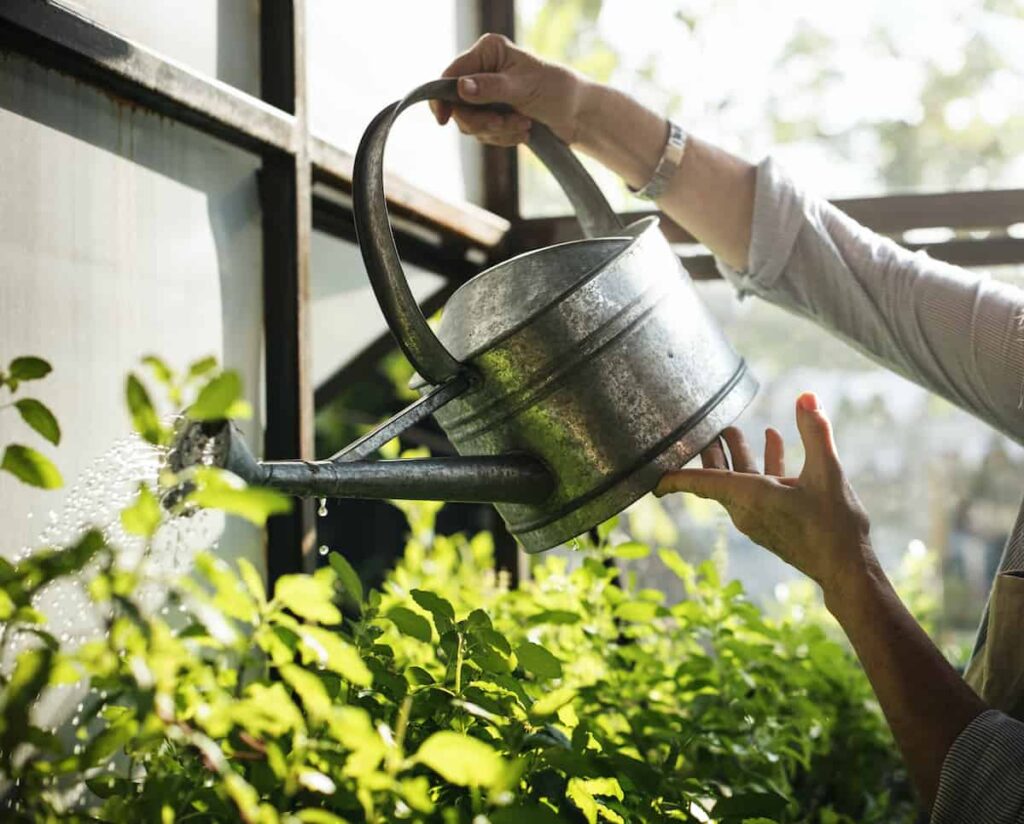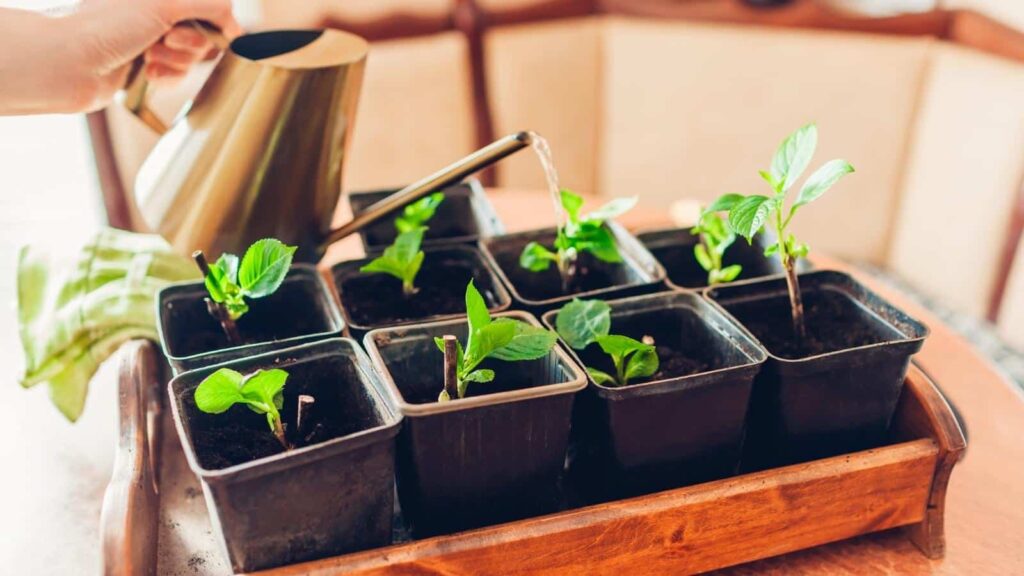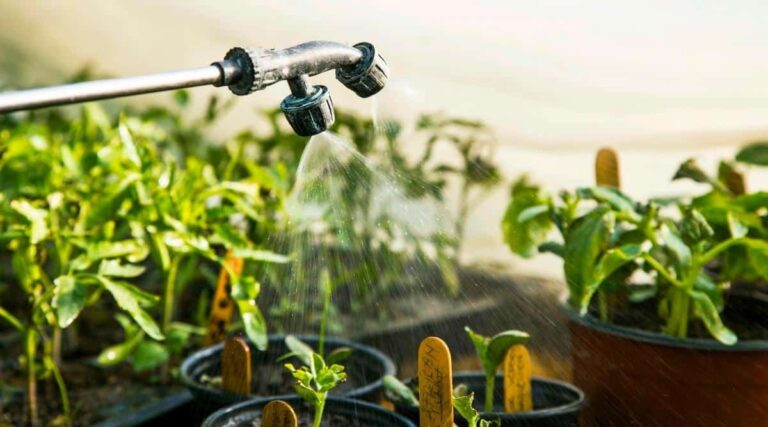It was my first time growing seedlings in a greenhouse, and I was excited to see them grow. Unfortunately, many of them didn’t make it because I didn’t know how to water them correctly. It was a sad experience that taught me the importance of understanding the unique watering needs of seedlings. I’ve learned this through trial and error, and I want to share my knowledge with you.
To ensure optimal growth and health of seedlings in a greenhouse, it is recommended to water them at least twice a day. It is crucial to maintain moist soil, and watering in the morning and evening will typically maintain these favorable conditions.
What are the key factors that determine the watering needs of seedlings in a greenhouse?

Understanding the watering needs of seedlings is crucial for successful growth in a greenhouse environment. Consistent moisture levels are essential, as seedlings have delicate root systems that are still developing and are more susceptible to both underwatering and overwatering compared to mature plants.
One of the key factors that affect the watering needs of seedlings is the type of plant. Each plant species has its own specific water requirements, so it is important to research and understand the needs of the particular seedlings you are growing. Some plants may require more water, while others may be more drought-tolerant.
The stage of growth also plays a significant role in determining the watering needs of seedlings. Initially, when seedlings have just germinated, they require less water as their root systems are not fully developed. As they grow and develop more leaves, their water requirements increase. It is important to monitor the growth stage of your seedlings and adjust your watering accordingly.
Temperature and humidity levels in the greenhouse also impact the watering needs of seedlings. Higher temperatures and lower humidity levels can cause faster evaporation, leading to more frequent watering. On the other hand, cooler temperatures and higher humidity may require less frequent watering. It is important to regularly monitor the temperature and humidity levels in your greenhouse to ensure optimal watering.
The choice of growing medium also affects watering requirements. Different mediums like soil, peat moss, or coco coir have different water retention capacities. It is crucial to choose a medium that provides adequate drainage while retaining enough moisture for the seedlings. Proper drainage is important to prevent waterlogged roots, which can lead to root rot.
In a greenhouse setting, there are various watering methods that can be employed to meet the watering needs of seedlings. Misting is a common method that involves spraying a fine mist of water over the seedlings. This method is useful for maintaining consistent moisture levels and preventing excessive drying out.
Bottom watering is another effective method where seedlings are watered from the bottom. This allows the roots to absorb water as needed without wetting the leaves, reducing the risk of fungal diseases. This method is particularly useful for seedlings in trays or pots.
Overhead watering, using a watering can or hose, is also commonly used. However, it is important to be cautious with this method as it can lead to water splashing on the leaves, which can promote the growth of fungal diseases. If using overhead watering, it is recommended to water in the morning so that the foliage has time to dry out during the day.
The frequency of watering seedlings will depend on various factors such as the type of plant, stage of growth, temperature, humidity, and growing medium. It is important to regularly monitor the moisture levels of the growing medium and adjust watering accordingly. Overwatering can lead to root rot, while underwatering can stunt growth and lead to wilting.
In conclusion, understanding the watering needs of seedlings is crucial for their successful growth in a greenhouse environment. Factors such as plant type, growth stage, temperature, humidity, and growing medium all play a role in determining their water requirements.
What are the best watering methods for seedlings in a greenhouse?
When choosing the right watering method for seedlings in a greenhouse, it is important to consider various factors to ensure optimal growth and water efficiency. One key consideration is to avoid overhead watering methods, such as sprinklers or misters. While these methods may be convenient, they can lead to several issues in a greenhouse setting.
Overhead watering increases the risk of fungal diseases by promoting moisture on the leaves and stems of the seedlings. This excess moisture can create a favorable environment for fungal growth and spread. Additionally, overhead watering can damage delicate seedlings, especially if the force of the water is too strong. It can also cause soil erosion, which can disrupt the root system and affect the overall health of the plants.
Instead of overhead watering, consider using drip irrigation as an efficient alternative. Drip irrigation involves using a network of tubes or pipes with small emitters that release water slowly and evenly. This method delivers water directly to the soil around the seedlings, minimizing water loss due to evaporation and runoff. By targeting the root zone, drip irrigation ensures that the water reaches the areas where it is needed most. It also helps prevent weed growth by delivering water only to the desired plants.
Another effective option for watering seedlings in a greenhouse is soaker hoses. These hoses have tiny pores or perforations along their length, allowing water to seep out slowly and directly into the soil. Similar to drip irrigation, soaker hoses deliver water at the root level, minimizing waste and promoting healthy root development. They are easy to install and can be placed strategically around the seedlings for targeted watering.
Bottom watering is another method that can be beneficial for young seedlings or delicate plants. This technique involves placing the seedling trays or pots in a shallow tray or container filled with water. The seedlings absorb water through capillary action, drawing it up from the bottom. Bottom watering ensures that the roots receive water directly and allows for thorough saturation of the soil. This method is particularly useful for plants that are susceptible to damage from overhead watering.
When selecting the right watering method, it is important to consider the size and layout of your greenhouse, the type of seedlings being grown, and your specific water conservation goals. Different plants may have specific preferences for watering techniques, so it is essential to research the requirements of the seedlings you are cultivating.
Watering Frequency and Timing
Watering in the morning and evening is ideal because these are the cooler parts of the day when evaporation rates are lower, allowing the plants to absorb more water. Watering during the hottest parts of the day can lead to excessive evaporation and may not provide enough time for the seedlings to take up the moisture.
However, it is important to note that the watering frequency and timing may vary depending on several factors. The type of plant being grown, its size, and the specific growing environment can all influence the water needs of seedlings. Some plants may require more frequent watering, especially those with shallow root systems or those that are fast-growing. On the other hand, established plants with deeper root systems may not need as much water and can tolerate longer periods between watering.
It is important to remember, the significance of applying the right amount of water during each watering session. Overwatering can lead to waterlogged soil, which can suffocate the roots and promote the growth of harmful fungi or bacteria. On the other hand, underwatering can cause dehydration and stunted growth in seedlings. It is crucial to find a balance by providing enough water to keep the soil consistently moist but not saturated.
To determine the appropriate amount of water needed for each session, greenhouse growers can consider factors such as the size of the container or growing bed, the moisture retention capacity of the soil or growing medium, and the stage of growth of the seedlings. It may be necessary to adjust the amount of water applied as the plants grow and their water requirements change.
By following these recommendations for watering frequency, timing, and amount, greenhouse growers can create an optimal environment for seedling growth and health. Consistently moist soil provides the necessary hydration for seedlings to develop strong root systems, absorb nutrients efficiently, and establish themselves for successful transplantation or further growth in the greenhouse.
How do I know if my plants are getting too much or not enough water?

Determining whether your plants are receiving the right amount of water is crucial for their health and well-being. Overwatering and underwatering are common issues that can lead to plant stress and even death if not addressed promptly. To identify if your plants are getting too much or not enough water, you need to pay attention to several key factors.
Firstly, observe the soil moisture. Stick your finger about an inch into the soil near the plant’s root zone. If it feels excessively wet or soggy, it’s a sign of overwatering. Conversely, if the soil is bone dry, it’s an indicator of underwatering. Ideally, the soil should be slightly moist but not saturated. Next, scrutinize the plant’s leaves. Wilting, yellowing, or browning leaves can be symptoms of both overwatering and underwatering. However, overwatered plants often exhibit softer, mushy leaves, while underwatered plants may have dry, crispy leaves. Consider the overall appearance of the plant – a healthy plant should have turgid, vibrant leaves.
Check the drainage in your plant containers. If there’s excess water pooling at the bottom of the pot or if the pot lacks drainage holes, it’s more likely that you’re overwatering. Proper drainage is essential to prevent root rot and other water-related issues.
Pay attention to the frequency of watering. Are you watering your plants too often or not enough? Different plants have different watering needs, so research the specific requirements for each type you’re growing. Also, take into account environmental factors like temperature and humidity, as they can influence a plant’s water requirements.
Lastly, consider the season and growth stage of your plants. They typically need more water during their active growth periods and less during dormancy. Adjust your watering schedule accordingly.
In conclusion, monitoring soil moisture, observing leaf health, ensuring proper drainage, adjusting watering frequency, and considering seasonal factors are all essential in determining whether your plants are receiving too much or too little water.
FAQs:
What is the best water for seedlings?
The best water for seedlings is room temperature, chlorine-free, and non-saline water. Rainwater or filtered water often work well. Avoid using water that’s too cold or contains high levels of chemicals.
What happens if seedlings get too wet?
If seedlings get too wet, their roots may suffocate due to reduced oxygen levels in the waterlogged soil. This can lead to root rot, stunted growth, and even the death of the seedlings.
How do you know if seedlings are too wet?
You can tell if seedlings are too wet by checking the soil’s moisture level. Insert your finger about an inch into the soil; if it feels excessively wet or soggy, the seedlings are likely too wet.
Do greenhouses use a lot of water?
The water usage in greenhouses varies but can be relatively high due to the need for consistent watering. Efficient irrigation systems and proper water management can help reduce consumption.
What is the best way to water a greenhouse?
The best way to water a greenhouse is to use a gentle spray from a watering can or hose to evenly moisten the soil. Water the base of the plants and avoid wetting the foliage to prevent diseases.
Should I put a bowl of water in my greenhouse?
Yes, placing a bowl of water in a greenhouse can help increase humidity levels, which can benefit certain plants. This is especially useful in dry climates or during the winter months when indoor heating reduces humidity.
What is the best time to water a greenhouse?
The best time to water a greenhouse is in the morning. This allows the plants to absorb moisture during the day and reduces the risk of fungal diseases that can develop in cool, damp conditions at night.
Final thoughts:
So, in conclusion, when it comes to figuring out how often to water seedlings in a greenhouse, it’s all about finding the right balance. You don’t want to drown them, but you also don’t want them to get too thirsty. It’s like giving them a drink when they’re thirsty but not forcing them to gulp down a whole glass.
Remember to consider factors like the type of plant, the stage of growth, and the weather. These things can all affect how often your seedlings need water. Pay attention to the soil moisture, and don’t forget to use the “finger test” to check if it’s time to water again.
In the end, taking care of your seedlings is a bit like taking care of a pet – you need to get to know their needs and give them the right amount of care. So, keep an eye on your little green friends, and with a little practice, you’ll become a pro at keeping them happy and healthy in your greenhouse.

